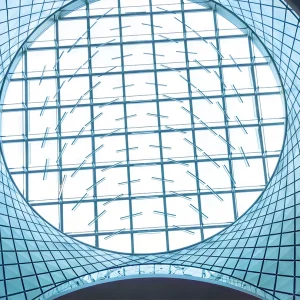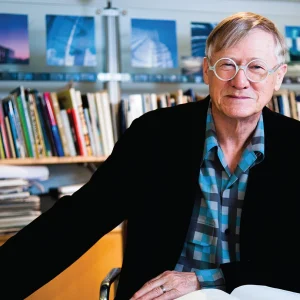
Even the most celebrated and spectacular sites in the world can still be shockingly anticlimactic in their lack of consideration for the visitor experience. For all the wrong reasons, I’ll never forget my trip to the pyramids: the approach comprised a sweltering journey through Cairo’s midday traffic in a cramped taxi, to be disgorged at the edge of the city’s suburban sprawl. And there they were: a trio of pyramids in the middle distance, barely visible and looking rather small against the desert background through heat haze and smog. Meanwhile, in the foreground, a man was very forcibly trying to sell me a camel ride.
The world’s most spectacular landscapes – areas of outstanding natural beauty or of massive historical significance – haven’t had much of a dialogue with modern design. Where interventions exist, they are largely aimed at infrastructure (traffic management and parking) or commerce (food and souvenirs). They are rarely masterpieces of contemporary design and architecture.
But a new crop of visionary structures is currently emerging, designed with great skill and ingenuity to provide the most inspiring and immersive experience of what’s left of our natural and ancient landscapes. Some of these are bold and exciting spaces that add drama to the experience. Others major on eco-friendly design and a subtle, contemporary aesthetic that sits gently within its surroundings.
As inspired examples of the latter, take Adam Khan’s RIBA award-winning Brockholes Visitor Centre (Civic Trust Awards winner twice over – including one for sustainability). A village-like grouping of simple timber buildings floats on a large pontoon at the edge of a lake, bringing the visitor right in among the reeds and wildfowl at the water’s edge. Or there’s van Heyningen and Haward’s Cory Environmental Centre for Essex Wildlife Trust in Thurrock Thameside Nature Park – a redevelopment of a former landfill site, intended to restore the natural wildlife habitats of the area. The visitor centre’s circular design is an exemplar for low-energy sustainability as well as offering 360-degree views of the surrounding flora, fauna and river traffic from its exterior ramp as it gently ascends to a roof terrace.
Among the grander designs, there are few more exciting than the forthcoming Grand Egyptian Museum in Cairo, by Heneghan Peng. Set just under 2km from the pyramids, it will house Egypt’s ancient treasures and be a carefully staged introduction to the splendours of the pyramids.
A monumental freestanding stone wall obscures the pyramids from view at the point of entry, its surface punctured with holes in geometric shapes so that sunlight patterns the interior during the day and artificial light floods out of it at night, creating a really spectacular gateway. The visitor enters through this wall to arrive at a shaded courtyard across which is a partially open-air staircase, flanked by magnificent ancient statues – Cleopatra foremost among them. It’s only from the top of the stairs that the panoramic vista of the pyramids and the whole Nile river valley is revealed.
Founding partner Róisín Heneghan says: ‘One of the things that drove this project was the whole experience of entering the museum. We wanted a contrast from the hurly-burly of Cairo. We didn’t want it to feel like you open a door and straightaway you are in a different, air-conditioned world. It’s designed as a series of transition spaces. First the shaded courtyard, then you gradually start to move into increasing levels of climate control. That was about trying to prepare people for the exhibition, to create a sense of anticipation. It’s also about environmentally reducing the amount of area you have that’s closely and artificially controlled.’
This visitor-friendly approach also includes ample outside space, with layers of roof terracing as well as gardens for visitors to enjoy the cooler Cairo nights. Says Heneghan: ‘The views at the top are amazing, and because it’s raised above the level of the city, it’s quieter. You can see the city and hear it but it feels like a world apart.’ In creating a fittingly impressive venue for viewing the pyramids, the architects have also given Cairo’s citizens a magnificent space for contemplating their own city.
Let’s hope the project, already part-way through construction, survives the upheavals caused by Egypt’s ongoing regime-change issues. One of the key elements that Heneghan hopes will not be ‘value-engineered’ out of the scheme is the landscaped plateau beside the building. Here, the planting is intended to replicate the lush farmlands of early Egyptian civilisation. Through the landscaping, says Heneghan, ‘We are trying to tell the story of how the landscape of Egypt evolved. Because of flooding, management of the landscape was one of the elements that allowed the civilisation to thrive. So much of Egypt’s history is told through the funerary side. We hoped that garden space would be a way to bring that living history alive to people.’
A world away from the heat and smog of Cairo, Heneghan Peng recently completed an equally impressive building, celebrating the ancient geological formations at Giant’s Causeway, in Northern Ireland. Here, the architects have designed a building that, in its stark beauty, echoes the spectacular basalt columns that project into the sea and along the coast.
The inspirations that informed their projects were, says Heneghan, ‘a lot of land art. And also thinking about things at a more infrastructural level – thinking at a bigger scale than the building and then working the building into the landscape’. In Cairo, the architects constructed a visual axis from the three pyramids and then shifted a lot of earth to place the museum’s top floor at the optimum sightline level. In Ireland, by contrast, they studied the natural topology of the site and partially buried the visitor centre behind the brow of a hill, so that the building does not interfere with the coastal ridgeline.
What inspired its Northern Irish client – the National Trust, not known for its new buildings – to allow them to do something so bold? Heneghan says: ‘The Trust was very supportive of the form for the causeway; very few people wanted something that looked like the site’s other buildings. Generally there was a huge amount of support for our building. The Trust’s Chair…[at the opening] said that what the Trust should be encouraging is buildings that would be considered heritage in 100 years.’
Max Bryant, the National Trust’s NI manager on the north coast told FX: ‘Over the years, visitors to this geological phenomenon have been intrigued and inspired by the unique elements that make up this iconic site. But as time moves on, so too has the Giant’s Causeway. With the development of a new world-class visitor facility, the site now offers an innovative and enhanced visitor experience you would expect at a World Heritage Site.’
Clients are increasingly trying to think more creatively, according to Chris Wilderspin, of van Heyningen and Haward, who designed the Essex Wildlife Trust building: ‘The client said what they didn’t want was a building that was just like any other visitor centre. They took the risk of commissioning a building right on the top of the landfill, which has views up and down the river and also of some neighbouring marshland.’ It would have been much easier, and cheaper, to build along the water, but this site really offered the best vistas. Says Wilderspin: ‘A lot of centres are quite commercially driven and this one has to make money, but the primary thing is the experience.’
The client’s courage has paid off, says Wilderspin: ‘In terms of numbers it’s far exceeded what they were expecting. We designed for 25,000 visitors and they had 60,000 in the first year. It’s partly where the site is and partly the way they make it accessible. They have done a lot of work with the local community. They even have tai chi on the roof. It’s almost like a community building.’ Not only have they built up their audience, but they’ve brought a new one to the site. Says Wilderspin: ‘That bit of Essex is relatively deprived. Through going out and engaging with the community, the EWT has people come out who would never have come to watch birds or boats or view nature.’
Wilderspin adds: ‘We are seeing heritage and nature bodies thinking in a different way. Not everyone wants to go and see a country house. People now might want to go and see something a bit more wild or a bit more modern. There’s a shift to places that have more resonance with the modern world.’
Grand Egyptian Museum
Cairo
The Grand Egyptian Museum sits at the edge of the first desert plateau between Cairo and its pyramids. Stacked up to construct a new ‘edge’ to the plateau – though without extending above it – the museum’s outer wall is a veil of translucent stone, punctured with geometric patterns, which transform from day to night. The building’s structure is informed by a set of visual axes from the site to the three pyramids, as well as by a sense of anticipation and revelation. The entrance through the wall leads to a shaded courtyard where visitors can choose to ascend the grand staircase to the top floor, where the pyramids are revealed in a panoramic vista. Or they can visit the conference and education centre – part of the museum’s planned cultural complex of activities devoted to Egyptology – which includes almost 24,000 sq m of permanent exhibition space, a children’s museum, a large conservation centre and extensive gardens on the 50ha site.
The structure of the building is concrete, with stone facades and interiors. Terracing provides opportunities for pause and reflection while improving natural ventilation and facilitating enjoyment of the outdoors at night – a popular Cairo activity. The form of the wall echoes the nearby pyramids, with a folding triangle pattern, evoking the geometric passions of ancient Egyptians.
Client: Ministry of Culture, Egypt
Architect: Heneghan Peng
Cost: £361m
Size: 100,000 sq m
Consultants: Architects (Cairo) RMC
Structural: Arup/ACE (Cairo)
Landscape: West 8/Sites (Cairo)
Specialist Lighting: Bartenbach Lichtlabor
Signage: Bruce Design
Cory Environmental Centre
Thurrock Thameside Nature Park
In 2009 van Heyningen and Haward won a competition to design a new visitor centre for the proposed Thurrock Thameside Nature Park for Essex Wildlife Trust – a redevelopment of the former Mucking landfill site. The building was intended as a statement of the Trust’s ambitions to restore the natural wildlife habitats of the area, as part of a series of green open spaces linked along the Thames. Its facilities include information and education resources, a variety of internal and external viewing points, plus cafe and shop. Rather than site the building alongside the river, it was decided to place it on top of the landfill pile in order to maximise views and appreciation of the landscape – despite all the structural problems that can pose. A circular form was chosen, partly inspired by the Martello towers that run along the east coast from Essex, but also to facilitate a fully accessible ramp for visitors that runs around the outside of the building all the way up to the roof terrace, providing 360-degree views of the surrounding parkland for everyone – whether buggy-pusher or wheelchair-user.
The construction and materials aim to minimise environmental damage through their exploitation or production. The building sits on a concrete ‘floating’ raft foundation. The main frame is steel, to reduce weight, cost and construction time. The exterior is larch weatherboarding combined with double-glazed, stained softwood windows. To minimize disturbance to wildlife, visitors are camouflaged by a vertical larch post ‘screen’ as they ascend. If it is too cold, or tiring, they can leave the ramp part way up and enter a cosy viewing room, complete with wood-burning stove and seating. A larger internal viewing room has panoramic views over the marshes. Thanks to dynamic programming and links with the surrounding community the building has received almost triple the number of visitors it anticipated – it was designed for 25,000 visitors and has already received 60,000 within its first year.
Client: Essex Wildlife Trust
Architects: Van Heyningen and Haward
Contract value: £2m
Completion date: July 2012
Tverrfjellhytta Reindeer Pavilion
Snøhetta was commissioned to create a highly durable and sustainable observation pavilion at Hjerkinn for viewing Europe’s last wild reindeer populations in one of Norway’s most treasured landscapes, overlooking the Dovrefjell National Park and the Snøhetta mountain massif. The Dovre mountains are written into Norwegian consciousness through ancient myths, mining legends, poetry (Ibsen) and music (Greig). This cultural and mythical landscape inspired the architectural response of a rigid outer shell with an organic inner core. The sculptural wooden seating along the south-facing exterior wall and interior creates a protected and inviting gathering space, with a wood-burning stove on the interior to warm the winter days and nights. The rectangular frame is made of raw steel (a reference to the iron found in local bedrock). The wooden furniture was created using skilled shipbuilders deploying digital 3D models to drive the milling machines, working with 25cm-square pine beams. The pieces were then assembled using only wood pegs as fasteners. Exterior wall furniture has been treated with pine tar, while the interiors are oiled. The result is a robust yet sophisticated building that maximises viewers’ immersion into and enjoyment of the surrounding landscape. Even the journey to the hut has been considered, with the creation of a 1.5km nature path bringing visitors to the site, some 1,200m above sea level.
Client: Norwegian Wild Reindeer Centre
Architecture, landscaping and interiors: Snøhetta Oslo
Cost: £448,400
Area: 90 sq m
Steel: Lonbakken AS
Glass: Skandinaviska Glassystem AB
Wood: Djupevaag Ship Builders AS
Floating Viewpoint
Camley Street Natural Park
Earlier in 2013, emerging Finnish architects Erkko Aarti and Arto Ollila’s floating viewing platform was selected as the winning entry to inhabit a rare slice of protected riverside, deep in the urban heartlands of King’s Cross, thanks to a competition run by The Architecture Foundation and the Finnish Institute in London on behalf of the London Wildlife Trust (LWT). Its future habitat – Camley Street Natural Park – is managed by the LWT and comprises two acres of wild green space along the Regent’s Canal.
Created from an old coal yard in 1984, the park offers city dwellers, schoolchildren and visitors a chance to immerse themselves in the restored and wildlife-filled waterway, surrounding wild meadows and woodlands. Aaarti & Ollila’s inspired idea was to situate the viewing platform actually on the water, giving visitors a chance to appreciate the site and its wild inhabitants from the middle of the canal itself. The brief was to make the structure as green as possible, minimising environmental impact while maximising visitors’ opportunities for getting up close and personal with nature.
The proposed wooden artificial island actually accommodates nesting and vegetation within its structure, while facilitating workshops and education programmes. It will be completed later this year with additional design input from Mikki Ristola. Aarti says: ‘We wanted to showcase the Finnish appreciation and respect for nature and give the visitors an exciting and enjoyable nature experience. Camley Street Natural Park is a unique and relaxing haven in the midst of a busy metropolis. The floating platform is sensitive to its surroundings, but it has its own identity and strong, recognisable shape that can be seen from afar.’
Client: London Wildlife Trust
Architecture and design: Erkoo Aarti, Arto Ollila and Mikki Ristola
Schedule: Opening autumn 2013
Giant’s Causeway Visitor Centre
Utilising the topology of this World Heritage Site, architecture practice Henghan Peng exploited and deepened two natural folds in the landscape: one, which extends the line of the ridge, accommodates the building; the other extends the level of the road and screens the car park from view. The building itself is inspired by the huge hexagonal basalt stones which are strewn along this ragged coastline – legend says they were thrown there by a mythical warrior named Finn MacCool to create a bridge to Scotland. As a fitting monument to this heroic endeavour, the entrance prow rises up 6m, its facade lined with marching pillars of polished black basalt – a stone that proved so fragile to work with it had to be sliced thinly and then stacked up in reinforced segments. Extensive glazing and a turf roof helps it blend further into the landscape.
The interiors are dramatic and spare, with polished concrete walls and floor into which basalt chips have been mixed. Maximising daylight and views was the priority, while roof lights magnify the sense of being exposed to the wild Northern Irish weather. Says founding partner Róisín Heneghan: ‘When you are in the building, there’s quite a lot of daylight. You can hear rain. You can hear the wind. You get a sense of the very powerful climate. We wanted it to feel like quite a raw space, to get that feeling of being aware of the weather. You are protected in some ways, but we didn’t want that feeling you get in a casino when there’s no sense of what’s going on outside.’
Client: National Trust
Architecture, landscape concepts and interiors: Heneghan Peng
Cost: £18m
Size: 1,800 sq m
Completed: July 2012
Structures: Arup





